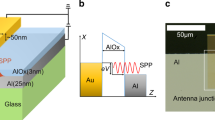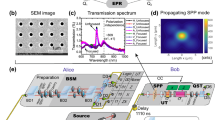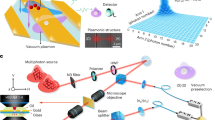Abstract
Surface plasma waves on metals arise from the collective oscillation of many free electrons in unison. These waves are usually quantized by direct analogy to electromagnetic fields in free space1,2,3, with the surface plasmon, the quantum of the surface plasma wave, playing the same role as the photon. It follows that surface plasmons should exhibit all the same quantum phenomena that photons do. Here, we report a plasmonic version of the Hong–Ou–Mandel experiment4, in which we observe unambiguous two-photon quantum interference between plasmons, confirming that surface plasmons faithfully reproduce this effect with the same visibility and mutual coherence time, to within measurement error, as in the photonic case. These properties are important if plasmonic devices are to be employed in quantum information applications5, which typically require indistinguishable particles.
This is a preview of subscription content, access via your institution
Access options
Subscribe to this journal
Receive 12 print issues and online access
$209.00 per year
only $17.42 per issue
Buy this article
- Purchase on Springer Link
- Instant access to full article PDF
Prices may be subject to local taxes which are calculated during checkout




Similar content being viewed by others
References
Elson, J. M. & Ritchie, R. H. Photon interactions at a rough metal surface. Phys. Rev. B 4, 4129–4138 (1971).
Tame, M. S. et al. Single-photon excitation of surface plasmon polaritons. Phys. Rev. Lett. 101, 190504 (2008).
Ballester, D., Tame, M. S. & Kim, M. S. Quantum theory of surface-plasmon polariton scattering. Phys. Rev. A 82, 012325 (2010).
Hong, C. K., Ou, Z. Y. & Mandel, L. Measurement of subpicosecond time intervals between two photons by interference. Phys. Rev. Lett. 59, 2044–2046 (1987).
Chang, D. E., Sørensen, A. S., Hemmer, P. R. & Lukin, M. D. Quantum optics with surface plasmons. Phys. Rev. Lett. 97, 053002 (2006).
Akimov, A. V. et al. Generation of single optical plasmons in metallic nanowires coupled to quantum dots. Nature 450, 402–406 (2007).
Kolesov, R. et al. Wave–particle duality of single surface plasmon polaritons. Nature Phys. 5, 470–474 (2009).
Heeres, R. W. et al. On-chip single plasmon detection. Nano Lett. 10, 661–664 (2010).
Di Martino, G. et al. Quantum statistics of surface plasmon polaritons in metallic stripe waveguides. Nano Lett. 12, 2504–2508 (2012).
Altewischer, E., van Exter, M. P. & Woerdman, J. P. Plasmon-assisted transmission of entangled photons. Nature 418, 304–306 (2002).
Fasel, S. et al. Energy–time entanglement preservation in plasmon-assisted light transmission. Phys. Rev. Lett. 94, 110501 (2005).
Fasel, S., Halder, M., Gisin, N. & Zbinden, H. Quantum superposition and entanglement of mesoscopic plasmons. New J. Phys. 8, 13 (2006).
Huck, A. et al. Demonstration of quadrature-squeezed surface plasmons in a gold waveguide. Phys. Rev. Lett. 102, 246802 (2009).
Politi, A., Cryan, M. J., Rarity, J. G., Yu, S. & O'Brien, J. L. Silica-on-silicon waveguide quantum circuits. Science 320, 646–649 (2008).
Ou, Z. Y. & Mandel, L. Derivation of reciprocity relations for a beam splitter from energy balance. Am. J. Phys. 57, 66–67 (1989).
Ou, Z. Y., Gage, E. C., Magill, B. E. & Mandel, L. Fourth-order interference technique for determining the coherence time of a light beam. J. Opt. Soc. Am. B 6, 100–103 (1989).
Ren, X.-F., Guo, G.-P., Huang, Y.-F., Wang, Z.-W. & Guo, G.-C. Plasmon assisted transmission of single photon wavepacket. Metamaterials 1, 106–109 (2007).
Wang, S. M. et al. Hong–Ou–Mandel interference mediated by the magnetic plasmon waves in a three-dimensional optical metamaterial. Opt. Express 20, 5213–5218 (2012).
Fujii, G. et al. Preservation of photon indistinguishability after transmission through surface-plasmon-polariton waveguide. Opt. Lett. 37, 1535–1537 (2012).
Heeres, R. W., Kouwenhoven, L. P. & Zwiller, V. Quantum interference in plasmonic circuits. Nature Nanotech. 8, 719–722 (2013).
Shoji, T., Tsuchizawa, T., Watanabe, T., Yamada, K. & Morita, H. Low loss mode size converter from 0.3 µm square Si wire waveguides to singlemode fibres. Electron. Lett. 38, 1669–1670 (2002).
Briggs, R. M., Grandidier, J., Burgos, S. P., Feigenbaum, E. & Atwater, H. A. Efficient coupling between dielectric-loaded plasmonic and silicon photonic waveguides. Nano Lett. 10, 4851–4857 (2010).
Barnett, S. M., Jeffers, J., Gatti, A. & Loudon, R. Quantum optics of lossy beam splitters. Phys. Rev. A 57, 2134–2145 (1998).
Acknowledgements
This work was supported by the Air Force Office of Scientific Research under MURI awards FA9550-12-1-0488 (J.S.F.), FA9550-12-1-0024 (H.L.) and FA9550-04-1-0434 (Y.A.K.). The authors thank the Kavli Nanoscience Institute at Caltech for access to and maintenance of fabrication equipment. Additionally, J.S.F. would like to thank R.M. Briggs for fabrication training and advice.
Author information
Authors and Affiliations
Contributions
J.S.F. and H.A.A. designed the experiment. J.S.F. and Y.A.K. built and tested the SPDC source. J.S.F. and H.L. built and tested the waveguide-coupling set-up. J.S.F. fabricated the waveguides. H.L. performed the measurements of quantum interference. All authors contributed to writing the manuscript.
Corresponding author
Ethics declarations
Competing interests
The authors declare no competing financial interests.
Supplementary information
Supplementary information
Supplementary information (PDF 491 kb)
Rights and permissions
About this article
Cite this article
Fakonas, J., Lee, H., Kelaita, Y. et al. Two-plasmon quantum interference. Nature Photon 8, 317–320 (2014). https://doi.org/10.1038/nphoton.2014.40
Received:
Accepted:
Published:
Issue Date:
DOI: https://doi.org/10.1038/nphoton.2014.40
This article is cited by
-
Mix and match
Nature Physics (2021)
-
Two-plasmon spontaneous emission from a nonlocal epsilon-near-zero material
Communications Physics (2021)
-
Light–matter interactions with photonic quasiparticles
Nature Reviews Physics (2020)
-
Quantum teleportation mediated by surface plasmon polariton
Scientific Reports (2020)
-
Quantum computing with graphene plasmons
npj Quantum Information (2019)



